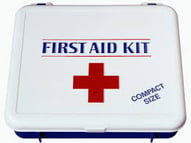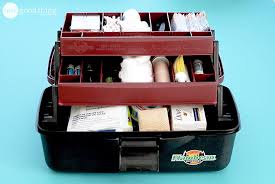At the beginning of a new year is a great time to go over equipment and safety items to be sure things will stay working right and that you will have what you need when that need arises.
So with that in mind for the next few weeks I will be going over these types of issues.

This week I will cover first aid kits. If you do not already have one, GET ONE. And for many of you that will mean having more than one. And as contractors, handling machines and chemicals everyday, the run of the mill buy off the store shelf, single person first aid kit is not going to cut it. Not even some of the made for companies kits from places like Uline will be perfect.
I will list for you things that should be in your contractor first aid kit for every 1-10 persons it will be expected to cover and with each additional 5-10 just do the multiplication yourself to up the numbers you need to have on hand.
One mistake many people make with a kit is to just toss in boxes of items from a store which can just over fill the space in the kit so that you stop putting in things you may really need to have with you. It is much better to have small amounts of a number of different items then a box of 250 band-aids! I suggest you go and buy a box or two of clear industrial grade zip bags in small sizes to put your supplies in, (3x4, 2x4), from a company like Uline. This way the contents will be protected, easy to see to find what is needed and you can store only what you need, taking up less space. But if not, using a box of zip lock snack bags can work. Buy medicaitions in individual dose packages if possible.
The size of the kit itself can vary depending on how many people you will need to cover so I suggest you gather the contents first and then find the container it will all fit in rather than buying a general kit and trying to stuff in the extra items that we are suggesting you should carry. I like hard sided cases vs. soft, to be more water proof and damage resistant. And my all time favorite is a DIY tackle box converted to a First Aid Kit. The only thing I would change with the one pictured is that the contents be in baggies so they stay clean and dry out in the field.

You need to cover the OSHA and ANSI standards for what should be in an employee first aid kit and build up from there. Here is the current ANSI requirements that covers 10 employees:
ANSI Z308.1-1998 – Minimum requirements for workplace first aid kits
Item Minimum Qty
Absorbent compress, 32 sq. in. (81.3 sq. cm.) no side under 4 in. 1
Adhesive bandages, 1x3 in (2.5 cm x 7.5 cm) 16
Adhesive tape, 5 yd. (457.2 cm) total 1
Antiseptic, 0.5g (0.14 fl oz.) / application 10
Burn treatment, 0.5g (0.14 fl oz.) / application 6
Medical exam gloves 2 pair
Sterile pads, 3 in. x 3 in. (7.5 x 7.5 cm) 4
Triangluar bandage, 40 in. x 40 in. x 56 in. (101cmx101cmx142cm) 1
First Aid guide 1
Here is my list to add to the basics:
1 Pair of medical bandage sissors
1 pair Splinter Forceps
5 each - Fabric elastic adhesive band-aids in multiple sizes; 1x3, knukle, butterfly, fingertip.
1 Roll Gauze 2 in. x 4 yd.
1 Ace elastic bandage wrap 3 in x 5 yd.
2 pair Nitrile gloves
1 Instant Cold pack 4x5 in.
1 Instant Hot compress 5x9 in.
1 tube of Insect bite ointment, spray or 6 wipes/towelettes
1 tube of Triple Antibiotic Ointment 1 oz. minimum
1 Bacitracin 1 oz.
1 finger splint
1 Bottle eye drops (for minor irritation or allergy) 0.5 oz.
1 eye wash 4 oz. (for emergency eye flushing)
1 Calgonate eye wash 4 oz. (If you use any amount of Hydroflouric Acid products)
2 eye pads/patches
12 doses Acetaminophen 500 mg. (can be packs of two or a small bottle of 24 pills)
12 doses Allergy tablets, Diphenhydramine HCL 25 mg.
6 cough drops
1 small bottle of Tums or antacid tablets
1 CPR shield/mask
1 digital thermometer
1 penlight
1 Emergency blanket
1 25g Tube Calgonate gel (If you use any amount of Hydroflouric Acid products)
There are other things that may come in handy you might want to include like blood clot powder or wound seal, or an elastic knee and elbow brace. Of course if you end up using anything out of the kit it should be replaced immediately upon returning to the shop, your office or home. Keep an inventory list in the kit and check it at least once a month to be sure it is complete. Having a different person do this at each of your monthly safety meetings is a good idea as it also gets each employee accustom to what is in the kit and where to find it. Something that could be needed with minutes count.
Here are a few places you can shop for supplies;
https://www.e-firstaidsupplies.com/
http://www.zeemedical.com/us/first-aid-supplies
https://www.masune.com/service/faq.asp